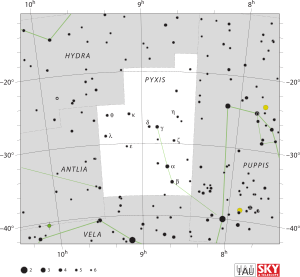astro.wikisort.org - Звезда
Альфа Компаса (α Pyxidis, α Pyx) — звезда-гигант в созвездии Компаса. Спектральный класс звезды равен B1.5III; звезда является переменной типа Беты Цефея. Данная звезда превосходит Солнце по массе более чем в 10 раз и по радиусу более чем в 6 раз. Температура поверхности составляет 24300 K, светимость превышает солнечную в 10 тысяч раз.[6][7][9] Звёзды с такой и большей массой заканчивают свою эволюцию во вспышке сверхновой.[12]
| Альфа Компаса | |
|---|---|
| Звезда | |
 | |
| Наблюдательные данные (Эпоха J2000.0) |
|
| Прямое восхождение | 08ч 43м 35,54с[1] |
| Склонение | −33° 11′ 10,99″[1] |
| Расстояние | 234,5821 ± 20,7238 пк[2] |
| Видимая звёздная величина (V) | 3,67[3] |
| Созвездие | Компас |
| Астрометрия | |
| Лучевая скорость (Rv) | +15,3[4] км/c |
| Собственное движение | |
| • прямое восхождение | –14,27[1] mas в год |
| • склонение | +10,43[1] mas в год |
| Параллакс (π) | 3,71 ± 0,14[1] mas |
| Абсолютная звёздная величина (V) | −3,47[5] |
| Спектральные характеристики | |
| Спектральный класс | B1.5III[6] |
| Показатель цвета | |
| • B−V | –0,19[3] |
| • U−B | –0,84[3] |
| Переменность | β Cep[7] |
| Физические характеристики | |
| Масса | 10,7[7] M⊙ |
| Радиус | 6,3 ± 1,0[8] R⊙ |
| Температура | 24 300[9] K |
| Светимость | 10 000[7] L⊙ |
| Металличность | -0,18[9] |
| Вращение | 11[10] |
| Коды в каталогах | |
| α Pyxidis, CPD−32° 2399, FK5 327, HD 74575, HIP 42828, HR 3468, SAO 199546.[11] | |
| Информация в базах данных | |
| SIMBAD | данные |
Название
В китайском языке название 天狗 (Tiān Gǒu) переводится как Небесная Собака и относится к астеризму, состоящему из α Компаса, e Парусов, f Парусов, β Компаса, γ Компаса и δ Компаса. Сама α Компаса известна как 天狗五 (Tiān Gǒu wǔ, пятая звезда Небесной Собаки.)[13]
Примечания
- van Leeuwen, F. (November 2007), Validation of the new Hipparcos reduction, Astronomy and Astrophysics Т. 474 (2): 653–664, DOI 10.1051/0004-6361:20078357
- Gaia DR2 (англ.) / Data Processing and Analysis Consortium, European Space Agency — 2018. — Vol. 1345.
- Fernie, J. D. New UBVRI photometry for 900 supergiants (англ.) // The Astrophysical Journal. — IOP Publishing, 1983. — May (vol. 52). — P. 7—22. — doi:10.1086/190856. — .
- Wilson, R. E. General Catalogue of Stellar Radial Velocities. — Институт Карнеги, 1953.
- Anderson, E. & Francis, Ch. (2012), XHIP: An extended hipparcos compilation, Astronomy Letters Т. 38 (5): 331, DOI 10.1134/S1063773712050015
- Hiltner, W. A.; Garrison, R. F.; Schild, R. E. MK Spectral Types for Bright Southern OB Stars (англ.) // The Astrophysical Journal. — IOP Publishing, 1969. — July (vol. 157). — P. 313. — doi:10.1086/150069. — .
- Hubrig, S.; Briquet, M.; De Cat, P.; Schoeller, M.; Morel, T.; Ilyin, I. New magnetic field measurements of beta Cephei stars and Slowly Pulsating B stars (англ.) // Astronomische Nachrichten : journal. — Wiley-VCH, 2009. — January (vol. 330, no. 4). — P. 317. — doi:10.1002/asna.200811187. — . — arXiv:0902.1314.
- Hubrig, S.; Ilyin, I.; Schöller, M. & Briquet, M. (January 2011), First Magnetic Field Models for Recently Discovered Magnetic β Cephei and Slowly Pulsating B Stars, The Astrophysical Journal Letters Т. 726 (1): L5, DOI 10.1088/2041-8205/726/1/L5
- Kilian, J. Chemical abundances in early B-type stars. 5: Metal abundances and LTE/NLTE comparison (англ.) // Astronomy and Astrophysics : journal. — EDP Sciences, 1994. — February (vol. 282, no. 3). — P. 867—873. — .
- Nieva, M. F.; Przybilla, N. Carbon abundances of early B-type stars in the solar vicinity. Non-LTE line-formation for C II/III/IV and self-consistent atmospheric parameters (англ.) // Astronomy and Astrophysics : journal. — EDP Sciences, 2008. — April (vol. 481, no. 1). — P. 199—216. — doi:10.1051/0004-6361:20078203. — . — arXiv:0711.3783.
- NSV 4220 -- Variable Star. SIMBAD. Centre de Données astronomiques de Strasbourg. Дата обращения: 23 февраля 2010. Архивировано 5 мая 2019 года.
- Reed, B. Cameron. New Estimates of the Solar-Neighborhood Massive-Stars Birthrate and the Galactic Supernova Rate (англ.) // The Astronomical Journal : journal. — IOP Publishing, 2005. — 28 June (vol. 130, no. 4). — P. 1652. — doi:10.1086/444474. — . — arXiv:astro-ph/0506708.
- (кит.) AEEA (Activities of Exhibition and Education in Astronomy) 天文教育資訊網 2006 年 7 月 17 日 Архивная копия от 4 февраля 2012 на Wayback Machine
Ссылки
- Kaler, James Alpha Pyxidis. University of Illinois. Дата обращения: 23 февраля 2010.
На других языках
[en] Alpha Pyxidis
Alpha Pyxidis, Latinised from α Pyxidis, is a giant star in the constellation Pyxis. It has a stellar classification of B1.5III and is a Beta Cephei variable. This star has more than ten times the mass of the Sun and is more than six times the Sun's radius. The surface temperature is 24,300 K and the star is about 10,000 times as luminous as the Sun.[3][4][8] Stars such as this with more than 10 solar masses are expected to end their life by exploding as a supernova.[11][es] Alfa Pyxidis
Alfa Pyxidis (α Pyx / HD 74575 / HR 3468) es la estrella más brillante de la constelación de Pyxis, la brújula, con magnitud aparente +3,68. Ocasionalmente recibe el nombre de Al Sumut, del árabe السموت al-sumūt, «camino» o «dirección» de la brújula.- [ru] Альфа Компаса
Текст в блоке "Читать" взят с сайта "Википедия" и доступен по лицензии Creative Commons Attribution-ShareAlike; в отдельных случаях могут действовать дополнительные условия.
Другой контент может иметь иную лицензию. Перед использованием материалов сайта WikiSort.org внимательно изучите правила лицензирования конкретных элементов наполнения сайта.
Другой контент может иметь иную лицензию. Перед использованием материалов сайта WikiSort.org внимательно изучите правила лицензирования конкретных элементов наполнения сайта.
2019-2025
WikiSort.org - проект по пересортировке и дополнению контента Википедии
WikiSort.org - проект по пересортировке и дополнению контента Википедии